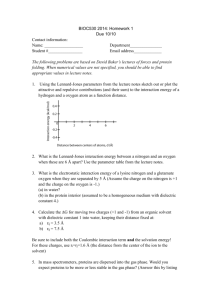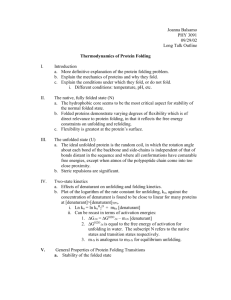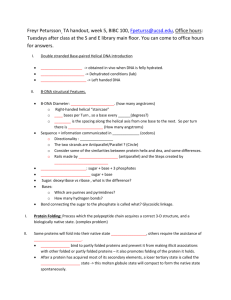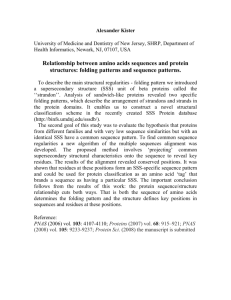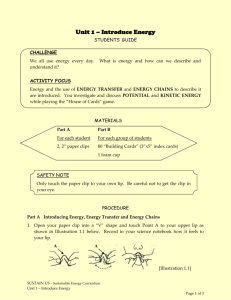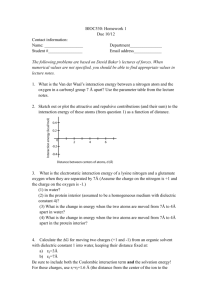The Protein Folding Problem
advertisement
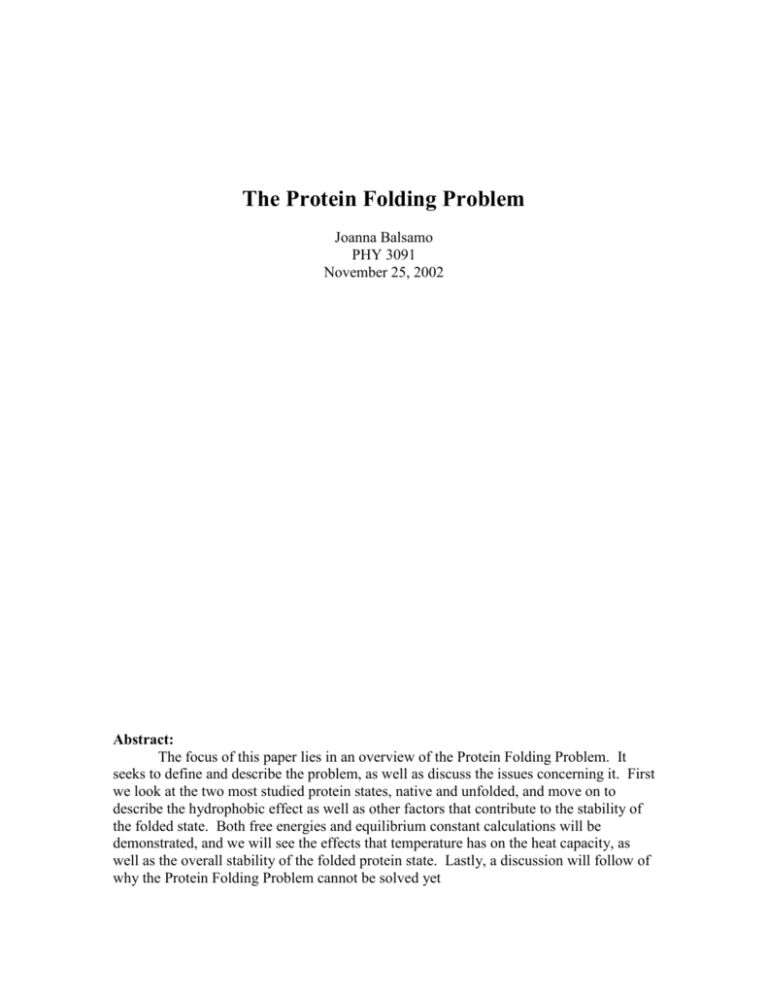
The Protein Folding Problem Joanna Balsamo PHY 3091 November 25, 2002 Abstract: The focus of this paper lies in an overview of the Protein Folding Problem. It seeks to define and describe the problem, as well as discuss the issues concerning it. First we look at the two most studied protein states, native and unfolded, and move on to describe the hydrophobic effect as well as other factors that contribute to the stability of the folded state. Both free energies and equilibrium constant calculations will be demonstrated, and we will see the effects that temperature has on the heat capacity, as well as the overall stability of the folded protein state. Lastly, a discussion will follow of why the Protein Folding Problem cannot be solved yet With their vital role in all living systems, proteins are the building blocks that form the foundation of any being. Compact three-dimensional structures and conformational flexibility determine the biological functions as these proteins interact with different molecules. Because of the important role that proteins play, biochemists and biophysicists have been focusing research in that area. Much of this research is directed towards The Protein Folding Problem. To be biologically active, proteins must develop a folded, three-dimensional structure. A structure, which is also referred to as the tertiary structure. However, the genetic information that is contained within a protein cell only specifies the primary, or linear, sequence of amino acids in the protein backbone. Because most proteins refold spontaneously after being forced to unfold, it has been determined that the threedimensional conformation of proteins is decided by the primary sequence of DNA. How the primary structure determines the three-dimensional structure has come to be known as the Protein Folding Problem. Motivations that are driving research in this arena span the fields of biology, biochemistry, pharmaceuticals, and biophysics. With the influx of information available from the human genome project, biologists are consumed with understanding the Protein Folding Problem in order to continue with the modeling of the cell. The pharmaceutical industry is investing their efforts into understanding the problem, Through careful examination of the Protein Folding Problem, one can draw three different, but related questions concerning the topic. The first of these questions is by what kinetic pathway does a protein adopt it’s native, or fully folded, state? This question seeks out the physical aspect of how a protein comes to be biologically active. The second question concerns the physical basis of stability in the folded, or tertiary, conformations. We begin to look and question the different factors that cause the protein to resist unfolding in normal conditions, in order to better understand how this conformation might come about. The third question is the one that still cannot be answered at this moment in time. Why does the amino acid sequence determine one particular folding process and the corresponding resultant three-dimensional structure, instead of another? Once answered, this question will hold the key to unlocking the Protein Folding Problem. Without it, research must continue in hopes to determine why exactly this occurs. With the race to explain the seemingly unexplainable, there are two teams who are working separately, but cooperatively together: the computational component and the experimental one. Both entities are essential, yet their work is on opposite ends of the spectrum. Consisting of mostly engineers, the computational component designs and develops the necessary algorithms, computer programs, and processes that will simulate folding. By examining folding simulation, one can determine reaction kinetics without ever having to step into a laboratory. However, this problem cannot be solved by theoretical work alone, and therefore the biological factor is probably most important. The importance lies in the fact that actual biological process of protein folding is not completely understood. Without this understanding, it is impossible to develop accurate computer simulations. Both research teams have the same ultimate goal in their sights even though the attainment of this goal is not imminent, to predict the folded tertiary protein structure from the primary sequence of amino acids. The starting and endpoint of virtually all protein folding studies are those conformational states that are stable at equilibrium, as these are the only states that can be characterized in detail. Only one of these states actually exists, and it is the native, or fully folded, state. Consisting of the three-dimensional globular protein structure, the native state is the protein that we find in nature. With its hydrophilic, polar barrier the hydrophobic, or water fearing, core is protected from solvation by the surroundings in which it survives. Formation of the hydrophobic core is due to the phenomena known as the hydrophobic effect. To demonstrate this effect, I have provided the following illustration and correlating explanation: The black and white circles represent hydrophobic and hydrophilic residues respectively. The shaded region represents the aqueous solvent. In order to maintain stability and resist solvation, the protein “curls” into a three-dimensional structure. This term describes the influences of an aqueous solvent to minimize the interaction of non-polar groups with the solvent. If this were to not occur, water molecules would hydrogen bond to the protein and eventually solvate it. The hydrophobic effect is one of the largest contributors in maintaining the stability of the folded state. Although unstable, the unfolded state has also been studied quite extensively. Ideally, unfolded proteins should resemble a random coil. The rotation angle about each bond of the backbone and the substituent side chain is independent of the other, distant, bonds in the amino acid sequence. All unfolded proteins have comparable free energies, regardless of which type of protein you are studying. Occurrences of deviation from this rule are rare, but may happen when atoms of the polypeptide chain come into too close of a proximity with one another. Currently, researches are using a reverse method to study how a protein folds. A process, which seems to be yielding valid, and reproducible results. By studying the way in which the protein unfolds in common denaturants, we can begin to piece the puzzle of folding together. The most common denaturants are Urea and Guanidine Hydrochloride (GuHCl). Each protein is unfolded in a variety of concentrations of denaturant, usually ranging from 0.05M to 2.0M. When added to the protein solution, the denaturant causes immediate unfolding, as shown below: However, this rate of unfolding is dependent upon the concentration of the denaturant due to the protein’s resistance, which is attributed to the stability of the folded state. From the various unfolding rate constants collected, researchers try and model the process in the reverse direction. Understanding the physical basis of stability of the folded state is crucial, for without it one cannot understand how such a conformation could be acquired. Although unfolding transitions can number as high as four, here we will focus on the single step unfolding process. This absence of partially-folded transition states makes it relatively easy to measure the equilibrium constant and free energy of folding within the transition region where both the native and unfolded state are populated. These constants can be measured by the formulas below: - Keq = [N]/[U] ΔGoN = GoN - GoU = RT ln Keq Where the value of ΔGoN is usually observed to be linearly dependent upon the concentration of denaturant buffer in the solution. Folded states of proteins are only marginally more stable than the unfolded state. Typical values of ΔGoN for small natural proteins are –20 to –40 kJ/mol, whereas the equilibrium constant between the native and unfolded states would have a value in the region of 104 to 107. The consequences of this difference in the equilibrium constant values teach us two things. The first is that under all conditions most proteins must spontaneously unfold. Secondly, the spontaneous folding will normally only be transient, because the protein will promptly refold. The enthalpies (ΔH) and entropies (ΔS) of unfolding are very temperature dependent. This is because the heat capacity of the folded state is significantly greater than that of the unfolded state. The heat capacity difference results primary from the temperature-dependent ordering of water molecules around the non-polar portions of the protein molecules – more of which are solvent accessible in the unfolded state. The large heat capacity change upon protein unfolding causes there to be a temperature at which stability of the folded state is at a maximum. Measured by free energy, the maximum occurs where ΔS = 0, while that measured by the equilibrium constant occurs where ΔH = 0. The stability of the folded state decreases at both higher and lower temperatures. Proteins may almost always be unfolded by raising the temperature sufficiently. Low temperature unfolding has the opposite thermodynamic characteristics of hightemperature, however, when you take the absolute value of the change in heat capacity you find that it remains constant All folded molecules have the same probability of unfolding, and the rate of unfolding usually changes uniformly with variation of the unfolding conditions. Once unfolded, we can begin to examine the process of protein refolding. The unfolded state consists of the primary sequence of amino acids. However, difficulty arises when kinetic complexities are encountered which usually result from conformational heterogeneity of the unfolded state. It is this process that holds the key to solving the elusive protein folding problem. The deluge of information that is available for analysis has created a pressing need to unlock the secrets of the primary DNA sequence. Continued research on folding kinetics will eventually bring about the solution to the problem, and once scientists have found it hundreds of opportunities will open up for the advancement on both the molecular level, and in the arena of new medicines. References: 1. Creighton, Thomas E. “Review Article: Protein Folding.” Journal of Biochemistry. December 1990. 2. Schindler, Thomas. “Extremely Rapid Protein Folding in the Absence of Intermediates.” Nature Structural Biology. August 1995. 3. Veitshans, T. “Folding Descriptions.” Journal of Biochemistry. July 1997.
